
Mascot, 12 Chapters, 1933. Starring John Wayne, Jack Mulhall, Raymond Hatton, Francis X. Bushman Jr., Ruth Hall, Hooper Atchley, Gordon DeMain, Robert Frazer, Al Ferguson, Edward Peil, George Magrill, and ? as El Shaitan.
Discounting a “condensed” version of The Crimson Ghost, The Three Musketeers was the very first movie serial I saw. While I unqualifiedly enjoyed some of the other serials I saw around that same time—serials like Don Daredevil Rides Again and Dangers of the Canadian Mounted—my childhood reaction to Musketeers was more complicated. While I liked leading man John Wayne, his fun-loving pals, and the Foreign Legion setting, I wound up more frustrated than pleased with the serial due to the confusing and just plain illogical shenanigans that centered round the riddle of the villain’s identity. Characters behaved as if they were the serial’s mystery villain–obscuring evidence that would have helped the heroes and even trying to kill the heroes–but were revealed as non-villainous at the end, leaving their earlier behavior unexplained. This plot haziness was enough to make a highly critical ten-year-old like myself write The Three Musketeers off as a lousy serial. However, having acquired in recent years a better understanding of the Mascot serials, which has led to my reevaluation of other serials like The Shadow of the Eagle, I realized that The Three Musketeers was long overdue for a critical reviewing.
The Three Musketeers begins with a large-scale action sequence, as a small troop of French Foreign Legionnaires give battle to a horde of Arabs; the Legionnaires, pinned down by heavy fire, drop one by one until only three are left. As the surviving trio prepares for a last heroic charge against hopeless odds, a biplane swoops down and drives off the Arabs with skilful machine gun fire. The Legionnaires’ rescuer proves to be Tom Wayne (John Wayne), an American flyer. He is enthusiastically thanked by the three Legionnaires—American Clancy (Jack Mulhall), German Schmidt (Francis X. Bushman Jr.) and French Renard (Raymond Hatton). It is Renard who dubs himself and his comrades “three modern musketeers” and Wayne their “D’Artagnan.”
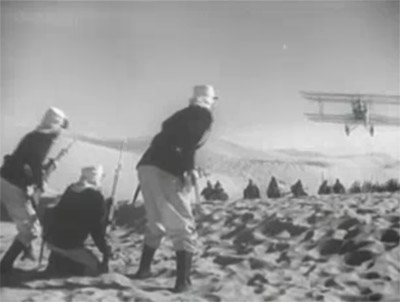
Above: The Three Musketeers face an Arab charge as Tom Wayne’s biplane zooms in to the rescue in the serial’s opening battle sequence. Note the impressive desert locations.
Wayne, who is attached to the American embassy in Paris, has flown down to North Africa to see his sweetheart, Elaine Corday (Ruth Hall), sister of a Legion officer. Unfortunately, Elaine’s brother Armand (Lon Chaney Jr.) is an unwilling member of the Devil’s Circle, a sinister Arab revolutionary society bent on overthrowing French rule. The Arabs that nearly finished off the “Musketeers” were members of the Devil’s Circle and followers of its leader, the mysterious El Shaitan. El Shaitan forces Armand to use Wayne as an unwitting tool to smuggle guns for the rebels from Paris. Things get even worse for our hero when he is accused of murdering Armand—who was actually killed by El Shaitan when he started to reveal part of the mysterious villain’s plan to Wayne. The Legion promptly charges Wayne with gunrunning and murder, and even Elaine Corday believes him to be guilty, thanks to a note written by Armand to clear Wayne but then mysterious altered in a way that fixes the flyer’s guilt. Only the Three Musketeers have faith in Wayne, and they set out to help their friend track down El Shaitan. The mysterious rebel chief could be the wily El Kadur (Hooper Atchley), a desert chieftain whose loyalty to France is supposedly beyond question. Or he could be Colonel Duval (Gordon DeMain), the truculent commander of the Legion post. Then there’s Major Booth (Robert Frazer), the American Secret Service Agent sent to extradite Wayne to Paris for trial, and Ali (Al Ferguson), the Cordays’ sneaky servant. Any one of these men (or none of them) could be El Shaitan, and the Musketeers and their D’Artagnan will only learn the truth after fighting their way through twelve chapters of action and danger.
Watching The Three Musketeers at a more mature age, I still find the same difficulties present that bothered me as a kid, but, surprisingly, the serial’s plot isn’t nearly as nonsensical as the storyline of some other Mascot serials; the guilty suspect is never shown together with the masked villain (as he was in Mystery Mountain), the bad guy’s schemes make sense (unlike the villainous shenanigans in Shadow of the Eagle) and a tolerant viewer can even retroactively explain nefarious behavior on the part of the suspects by concluding that one was posing as a bad guy in order to undermine the villains, another was actually a secondary villain, and so forth. However, none of these explanations are really “spelled out” on film, and even a tolerant viewer can be excused some irritation at being forced to do the writers’ work for them. The writers in question, Norman Hall, Ben Cohn, Wyndham Gittens, and Colbert Clark (who also co-directs the serial), can take the blame for this inexactitude, but also the credit for maintaining a fair degree of coherency.
Once the serial is set alongside its Mascot contemporaries instead of the more coherent Republic serials I used to compare it with years ago, it ranks among the best of that studio’s cliffhangers. The unique Foreign Legion background, which is reinforced by some impressive location shooting, sets the cliffhanger apart from more familiar crime and western outings. The serial’s cast is a pleasure to watch, and the action sequences, well-directed by Armand Schaefer and Colbert Clark and well-staged by stuntmen Yakima Canutt, Ken Cooper, and George Magrill, are quite exhilarating.
Most of the serial’s location shooting is in the sandy wastes of California desert areas like Buttercup Valley and Imperial County, as well as Arizona’s Yuma region; these locations fill in nicely for the Sahara, and serve as a visually striking setting for the horseback chases and battles that rage up and down their dunes. Bronson Canyon also figures into the scenery as one of the Devil’s Circle’s hideouts, while the Mascot back lot furnishes convincing North African streets and forts that seem to be the same sets used as Mexican towns and forts in later Republic B-Westerns (thanks to the Moorish influence on Spanish architecture, the buildings can play either role handily). The action that takes place against these backdrops is energetic and imaginative, though obviously not as choreographed as later serials’ fight scenes became following Mascot’s merger into the new Republic Pictures. Some action highlights are John Wayne tackling an Arab horseman from the wing of a moving biplane, some spirited fights in the city streets between the Three Musketeers and Arab mobs, a lengthy chase around an abandoned fort in which Wayne leaps from rooftop to rooftop while dodging the villains, Wayne’s final fight with the unmasked El Shaitan, the opening battle scene, and a wonderful sequence in which the Three Musketeers split up to take out a party of Arabs pursuing Ruth Hall, each handling a small group of antagonists in his own way.

Above: Wayne (on horseback) is cornered by an angry mob in one of the serial’s convincing Arabian back-street sets.
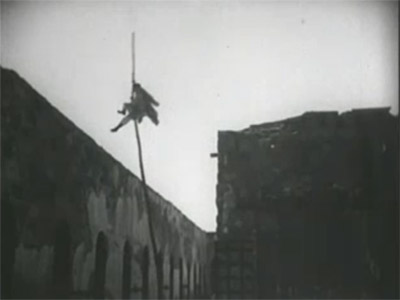
Above: Wayne (or his stuntman) vaults from roof to roof of an old fort.
The serial’s cliffhanger sequences are interesting in that many feature the good guys being apparently shot or stabbed, but then actually being wounded in the next installment, instead of merely ignoring or shrugging off their injury as most serial protagonists do. One shocking cliffhanger has heroine Ruth Hall being struck by a thrown knife and falling from her horse (and she does take some time to recover), while another cliffhanger has Wayne shot off a fort roof by El Shaitan; he also doesn’t just get up at once. Another memorable chapter ending has the Three Musketeers reluctantly forced into joining a firing squad scheduled to execute Wayne, while Ruth Hall rushes towards the execution scene with a reprieve and runs into the squad’s rifles just as they open fire; the resolution of the scene is quite entertaining.
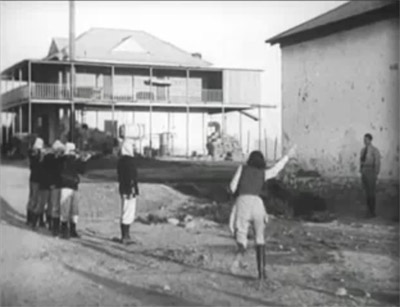
Above: The firing squad cliffhanger.
One of the interesting aspects of The Three Musketeers is the way it splits up the action between its various protagonists. While John Wayne’s character is the hero, the Three Musketeers take billing above him, and justify it by carrying large parts of the action themselves (along with leading lady Ruth Hall), especially during two chapters when Wayne is incarcerated by the Foreign Legion. The Musketeers aren’t just “sidekicks,” but co-stars, and the actors playing them make the most of their unusually large roles. Jack Mulhall is delightful as the scrappy, talkative, charge-ahead Clancy, while Raymond Hatton surprises by playing Renard as the most dignified, responsible, and soldierly member of the trio—a far cry from the rowdy, grizzled old geezers he usually played. Tall and handsome Francis X. Bushman Jr. also plays against type in his role of the huge and somewhat slow-witted Schmidt, whose food-loving ways provide subdued but highly amusing comic relief. All three deliver excellent performances, and the many bits of interaction among them are very enjoyable, including them the opening scene in which they face their seeming doom with grim humor, and the amusing sequence in which Schmidt’s addiction to sausages inadvertently helps them thwart an Arab raid on the Legion post.
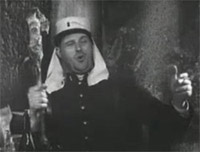

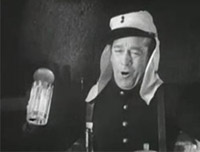
Above, from left to right: Francis X. Bushman Jr., Raymond Hatton, and Jack Mulhall share a lighter moment in a street cafe.
John Wayne happily manages to avoid being overshadowed by such a colorful band of co-stars; even at this early stage in his career he shows more presence and acting ability than your average serial lead. While most cliffhanger heroes have to convey both happy-go-lucky cheerfulness and grim determination, few do it so wholeheartedly as Wayne, and almost none can convey alarm, sorrow, or even rage as well as he can—and, of course, he has more than enough athleticism to be convincing in the action sequences. His naturally low-key personality counterbalances the energy with which he throws himself into his performance, and thus he comes off as neither over-theatrical nor wooden, twin curses that beset many 1930s serial leading men.
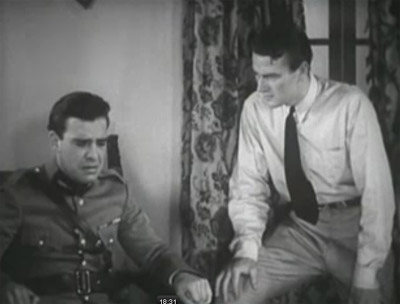
Above: Wayne questions Lon Chaney Jr. about El Shaitan.
Wayne particularly comes off as natural and believable when playing off some of the “old stagers” among the supporting cast. Hawk-faced Robert Frazer, as Major Booth, is probably the biggest scenery-chewer among the “suspect” actors, glowering continually and rolling his resonant voice as if he’s trying to reach a theater’s back seats. Stocky, scowling Gordon DeMain, as Colonel Duval, is more restrained, but ranges into the grand style sometimes himself, particularly in scenes with Frazer. Hooper Atchley is subdued by comparison, but extracts every ounce of drama from his El Kadur role by using a sly, deliberate delivery to emphasize his character’s shiftiness. All three actors are a lot of fun to watch and do a fine job in their parts, even though half of their suspicious actions are never really explained satisfactorily. The villainous El Shaitan himself is one of Mascot’s most impressive mystery villains, stalking from crime to crime in his flowing robes and announcing his arrival in booming tones to his assembled “Devil’s Circle” in a darkened meeting room.
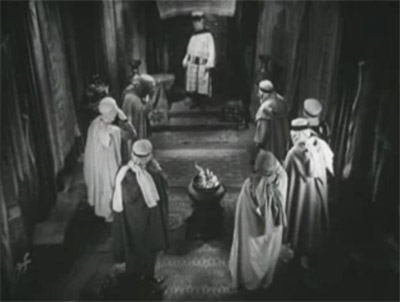
Above: El Shaitan (center, on the steps) presides over a meeting of the Devil’s Circle.
Pretty, high-voiced heroine Ruth Hall is rather off-putting in the first couple of chapters, but this is due to the screenplay, which makes her character too ready to believe that the man she loves has killed her brother and too eager to take immediate vengeance on the supposed culprit. Once she’s convinced of Wayne’s innocence, she becomes much more endearing, as she spends the rest of the serial taking an active part in the quest to clear Wayne, risking her life several times in the process. Lon Chaney Jr. only appears briefly as her brother Armand, but does very well as a conflicted, tortured character that almost seems at times to anticipate his famous Wolf Man characterization eight years later.
Stuntman George Magrill plays El Shaitan’s chief henchman, El Mahgreb, until he’s killed off for betraying his master. Dark, long-faced Al Ferguson, who looks more Arabic than most of the other actors playing the natives, but whose Irish brogue rather clashes with his appearance, does a good job as the sneaky servant Ali. Edward Piel is the dignified storekeeper Ratkin, William Desmond and Robert Warwick appear briefly as, respectively, a Foreign Legion Captain and an American Embassy officer, while Frank Ellis and Kermit Maynard (who also participates in the serial’s stunt work) have bits both as Arabs and Legionnaires. Special mention should go to Noah Beery Jr., who plays Wayne’s easy-going, fun-loving mechanic pal in the first two chapters. His character is a sidekick in same vein as his later “Skeeter” in the two Tailspin Tommy serials, which makes it a real shock when he is killed off. Beery does a beautifully moving job in his death scene, and Wayne’s grief-stricken and then furious reaction to his partner’s death complements it.
One of the serial’s added bonuses is its soundtrack; while The Three Musketeers, like most Mascot serials, lacks a music score, it does have two nifty theme songs–a rousing battle song (“It’s always forward the Legionnaires!”) that plays over the credits and occasionally within a chapter, and a jovial song sung by the Three Musketeers in lighter moments (“One we live, two we die, and three we take a chance–for we are the Three Musketeers…”) Both songs have catchy tunes that add to the energy of the serial.
The Three Musketeers, because it stars John Wayne, will probably continue to be one of the first serials that a casual movie fan picks up. In a way, that’s a pity, since it can perhaps be more fully appreciated by a veteran serial viewer–one well acquainted with the Mascot Pictures formula, who can rate the serial against its peers. However, first-time viewers more patient and less critical than I was in my childhood might still be able to overlook the serial’s plot confusions (almost inevitable under the Mascot banner) and enjoy its rousing action and lively performances (also inevitable, though much more welcome, once the Mascot logo has flashed upon the screen).
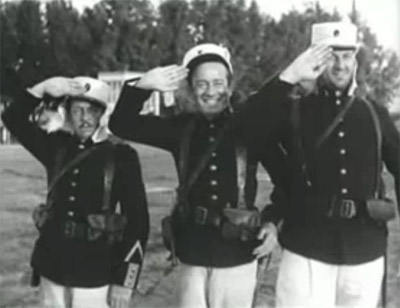
Typical Mascot – plenty of action scenes, full of contradictory and confusing plot elements and sometimes sloppy writing, endless “red herrings”, and yet despite the flaws, always very entertaining.
I’ve never been a particular fan of John Wayne’s films, but I’ve really grown to love his serials. He’s very enthusiastic and stalwart as the hero, believeable handling the physical demands of the action, and he displays enough acting “chops” not to be overshadowed by the other players.
Overall, I wasn’t enthused with Ruth Hall’s performance, but as you point out, the initially unsympathetic way the character is written makes it difficult to warm to her. It was very surprising that Noah Beery, Jr was killed off so early, but it does make for good drama and gives him a nice showcase. The same is true for Lon Chaney, Jr, an underated actor who could deliver intensity and emotion when given the chance. I think the comparison to his “Wolfman” role is spot-on.
Hatton, Mulhall and Bushman, Jr are all very good as the “Musketeers”, as are the great collection of villains and supporting players. Everyone of the main suspects takes a turn as being “El Shaitan”, so as usual with Mascot, you never know until the end who the true villain is, and even then the explanation isn’t always convincing or logical. The sets and the “desert” location scenes all add some nice flavor as well.
These early serials certainly aren’t to everyone’s taste. I enjoyed reading your review, as always, but I was especially interested in your reasons for doing a reappraisal. I came to know Mascot only after discovering this site, and my concepts, like and dislikes for serials in general had initially been formed mostly from watching the 40’s Republic productions when I was a teenager in the 60’s, and then often in their 100 minute condensed versions shown on television. It certainly was an eye-opener to finally view some of these older chapterplays and see such a different style.
As another poster mentioned recently, the pandemic is giving many of us plenty of free time, and watching (or rewatching) some of these favorites is as good way as any to pass the hours.
I speak from the point of view of a nine-year-old watching this serial in 1957 as part of the 2-hour Saturday morning cartoon show on our local station in Boston. 8AM was when they would run one chapter a week of a 1930s serial. I was fascinated by The Three Musketeers and took note of everyone’s suspicious actions. I changed my mind about who El Shaitan might be every week.
Because of a burned-out tube in our living room TV (a cabinet model with dark wood doors that closed to cover the screen and controls), I didn’t get to see Chapter 12 until about 45 years later courtesy of the Internet and my trusty monitor. I enjoyed getting to finally complete the serial, but once again I guessed the wrong person as El Shaitan..
Of the other early serials I saw back then, including Last of the Mohicans, The Phantom Empire, one of the Clyde Beatty jungle serials, and The Miracle Rider, The Three Musketeers and their theme song is the one that comes to mind first.